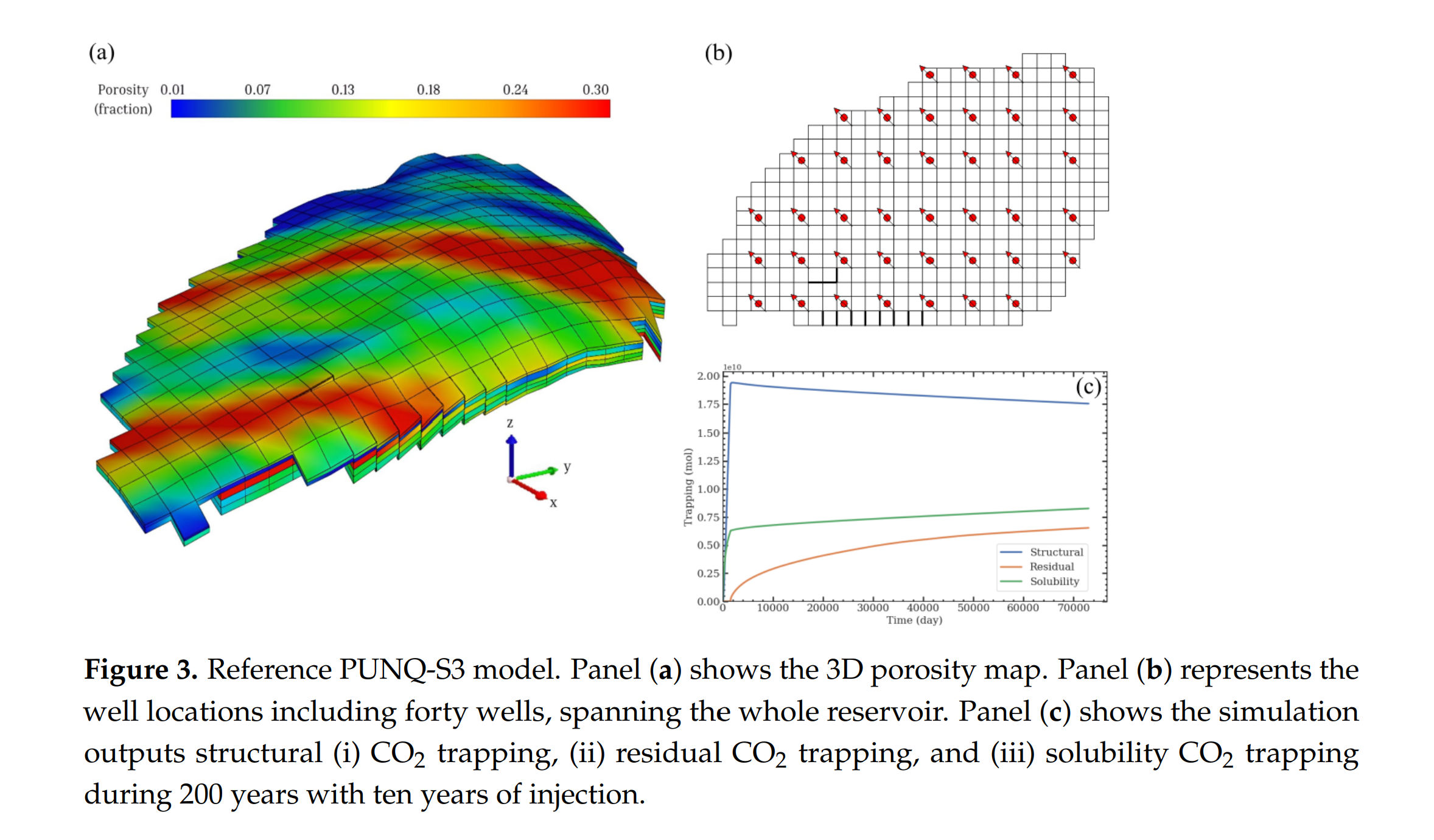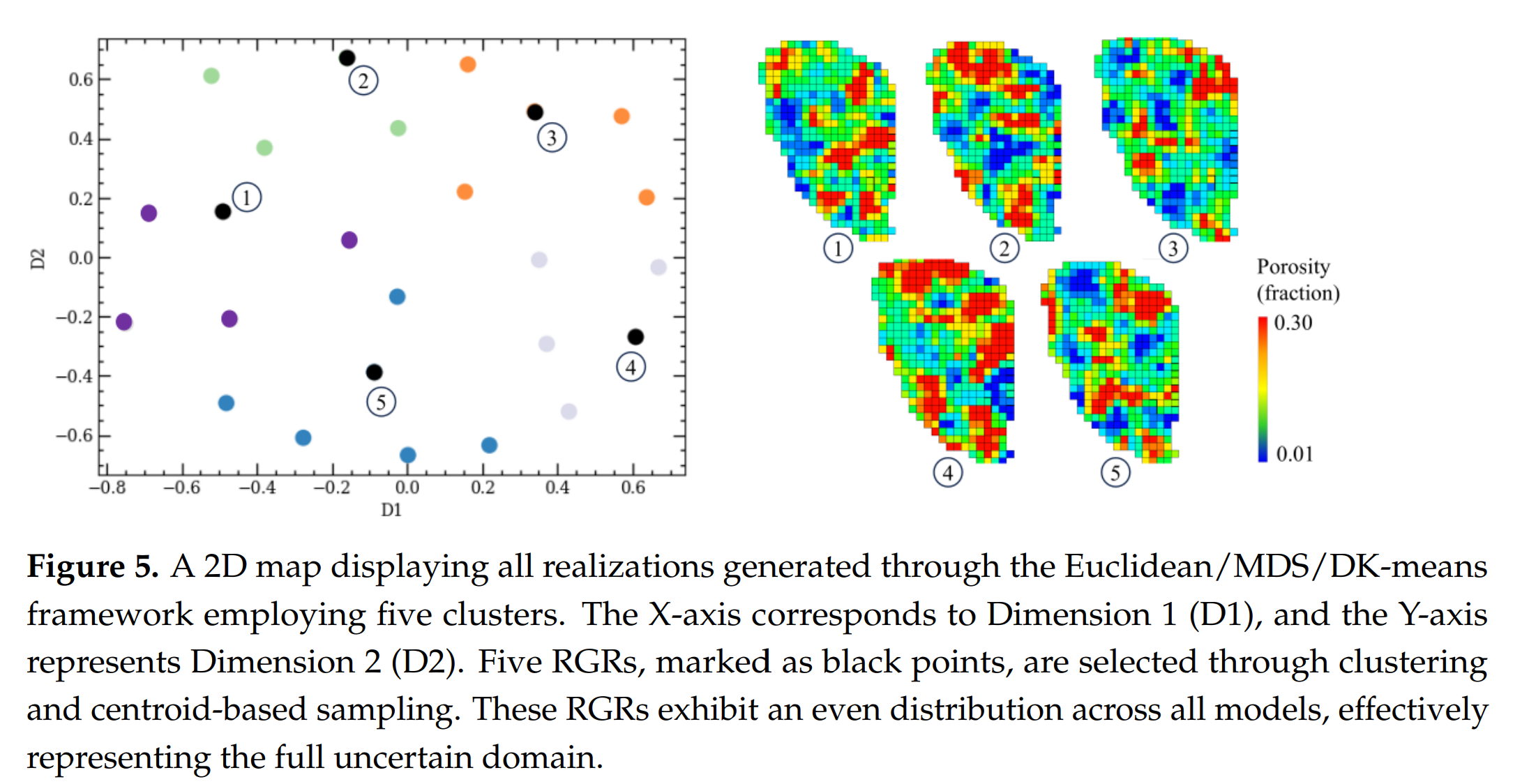Uncertainty Quantification in CO2 Trapping Mechanisms: A Case Study of PUNQ-S3 Reservoir Model Using Representative Geological Realizations and Unsupervised Machine Learning
本研究提出了一种有效的方法来评估CO2注入预测中的不确定性,这通常需要大量的高分辨率地质实现(GRs),虽然有效,但计算成本很高。作为解决方案,本研究提出了使用代表性地质实现(RGRs)的方法,以高效的方式捕捉完整数据集的不确定性范围,同时减少计算成本。利用集成的无监督机器学习(UML)框架,包括欧几里得距离测量、多维尺度(MDS)和确定性K均值(DK-means)聚类算法,从25个可能的地质实现中选择5个RGRs(占总数的20%)。UML方法考虑了储层质量指数(RQI)作为储层的静态参数。为了验证这些RGRs的可信度,通过应用Kolmogorov–Smirnov (KS) 测试来分析输出分布,对比了RGRs和完整数据集的模拟结果。在这项评估中,40个CO2注入井覆盖了整个储层以及完整数据集。终点模拟结果显示,RGRs和完整数据集中的CO2结构性、残余性和溶解性捕获遵循相同的分布。模拟五个RGRs以及完整数据集的25个GRs超过200年,涉及10年的CO2注入,揭示了一致的捕获分布模式,平均Dmax值为0.21,保持在Dcritical(0.66)以下。使用这种方法,可以大幅降低存在地质不确定性的CO2存储储层情景测试和开发规划的计算费用。
CMG软件应用情况
在本研究中,CMG-GEM作为商业流动模拟器,用于处理模拟输出,并对RGRs和完整数据集的模拟结果进行比较。CMG-GEM用于模拟CO2的构造捕集、束缚空间捕集和溶解捕集,这些模拟输出被用来评估和比较RGRs与完整数据集之间的不确定性。研究结果表明,通过CMG-GEM软件得到的RGRs的模拟结果与完整数据集的模拟结果具有相同的分布模式,证明了RGRs能够有效代表完整数据集。
这项研究对于理解和改进CO2地质封存的效率和可靠性具有重要意义,特别是在面对地质不确定性时。通过使用UML和CMG-GEM软件,研究者能够更有效地评估和管理与CO2捕获相关的不确定性。
作者单位
- Seyed Kourosh Mahjour 和 Jobayed Hossain Badhan:德克萨斯州立大学英格拉姆工程学院的Geo-Intelligence实验室,美国德克萨斯州圣马科斯。
- Salah A. Faroughi:塔尔顿州立大学的Texas Institute for Applied Environmental Science (TIAER),美国德克萨斯州斯蒂芬维尔。
Evaluating uncertainty in CO2CO2 injection projections often requires numerous high-resolution geological realizations (GRs) which, although effective, are computationally demanding. This study proposes the use of representative geological realizations (RGRs) as an efficient approach to capture the uncertainty range of the full set while reducing computational costs. A predetermined number of RGRs is selected using an integrated unsupervised machine learning (UML) framework, which includes Euclidean distance measurement, multidimensional scaling (MDS), and a deterministic K-means (DK-means) clustering algorithm. In the context of the intricate 3D aquifer CO2CO2 storage model, PUNQ-S3, these algorithms are utilized. The UML methodology selects five RGRs from a pool of 25 possibilities (20% of the total), taking into account the reservoir quality index (RQI) as a static parameter of the reservoir. To determine the credibility of these RGRs, their simulation results are scrutinized through the application of the Kolmogorov–Smirnov (KS) test, which analyzes the distribution of the output. In this assessment, 40 CO2CO2 injection wells cover the entire reservoir alongside the full set. The end-point simulation results indicate that the CO2CO2 structural, residual, and solubility trapping within the RGRs and full set follow the same distribution. Simulating five RGRs alongside the full set of 25 GRs over 200 years, involving 10 years of CO2CO2 injection, reveals consistently similar trapping distribution patterns, with an average value of 𝐷max�max of 0.21 remaining lower than 𝐷critical�critical (0.66). Using this methodology, computational expenses related to scenario testing and development planning for CO2CO2 storage reservoirs in the presence of geological uncertainties can be substantially reduced.



